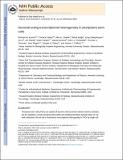Deconstructing transcriptional heterogeneity in pluripotent stem cells
Author(s)
Kumar, Roshan M.; Cahan, Patrick; Shalek, Alex K.; Satija, Rahul; DaleyKeyser, AJay; Li, Hu; Zhang, Jin; Pardee, Keith; Gennert, David; Trombetta, John J.; Ferrante, Thomas C.; Regev, Aviv; Daley, George Q.; Collins, James J.; ... Show more Show less
DownloadRegev_Deconstructing transcriptional.pdf (2.976Mb)
PUBLISHER_POLICY
Publisher Policy
Article is made available in accordance with the publisher's policy and may be subject to US copyright law. Please refer to the publisher's site for terms of use.
Terms of use
Metadata
Show full item recordAbstract
Pluripotent stem cells (PSCs) are capable of dynamic interconversion between distinct substates; however, the regulatory circuits specifying these states and enabling transitions between them are not well understood. Here we set out to characterize transcriptional heterogeneity in mouse PSCs by single-cell expression profiling under different chemical and genetic perturbations. Signalling factors and developmental regulators show highly variable expression, with expression states for some variable genes heritable through multiple cell divisions. Expression variability and population heterogeneity can be influenced by perturbation of signalling pathways and chromatin regulators. Notably, either removal of mature microRNAs or pharmacological blockage of signalling pathways drives PSCs into a low-noise ground state characterized by a reconfigured pluripotency network, enhanced self-renewal and a distinct chromatin state, an effect mediated by opposing microRNA families acting on the Myc/Lin28/let-7 axis. These data provide insight into the nature of transcriptional heterogeneity in PSCs.
Date issued
2014-12Department
Massachusetts Institute of Technology. Department of BiologyJournal
Nature
Publisher
Nature Publishing Group
Citation
Kumar, Roshan M., Patrick Cahan, Alex K. Shalek, Rahul Satija, A. Jay DaleyKeyser, Hu Li, Jin Zhang, et al. “Deconstructing Transcriptional Heterogeneity in Pluripotent Stem Cells.” Nature 516, no. 7529 (December 3, 2014): 56–61.
Version: Author's final manuscript
ISSN
0028-0836
1476-4687